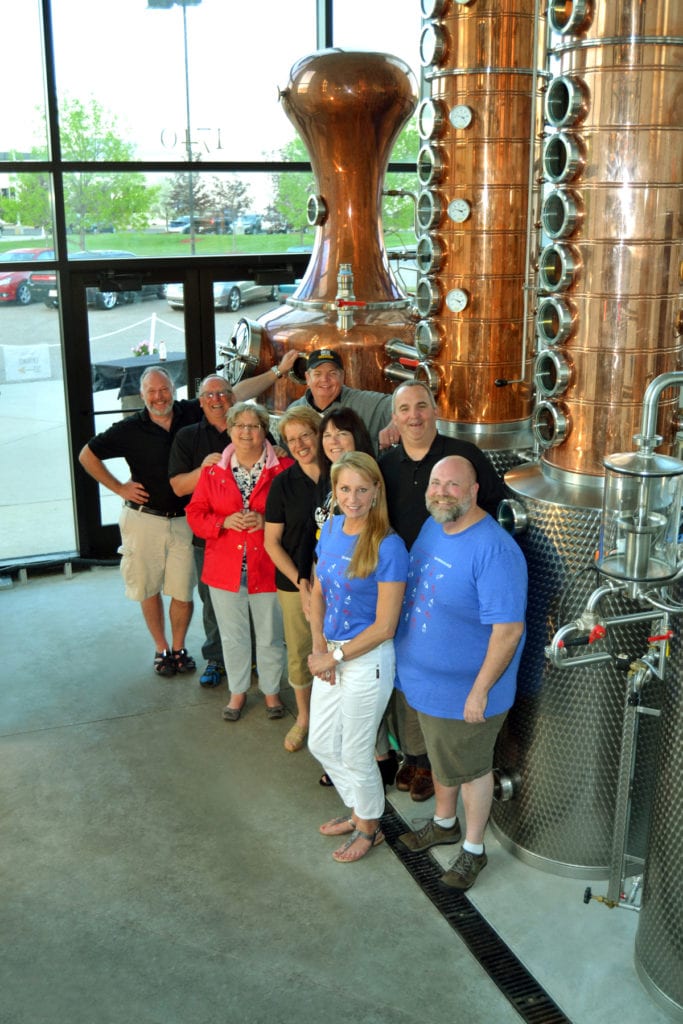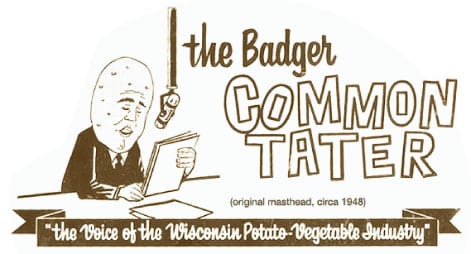Wisconsin Potato Vodka Distilleries

by Ruth Faivre, Managing Editor
Gaining steam, potato vodka is quickly making a name for itself in Wisconsin thanks to two fairly new distilleries, Great Northern Distilling in Plover, WI and Hendricks Family Distillery in Omro, WI.
While there are distinct differences between the two distilleries, their facilities, raw materials and vodkas, one thing they share is an entrepreneurial spirit that led the founders of both companies to jump in, full speed ahead.
Another similarity exists in the distilling process itself. While most vodkas are distilled by large ethanol American and European producers, who then sell grain-neutral spirits to rectifiers and bottlers, both Great Northern Distilling and Hendricks Family Distillery distill their own vodka.
GREAT NORTHERN DISTILLING
Great Northern Distilling, formed by a group of investors and headed by Brian Cummins, company Founder and Head Distiller, opened a little over a year ago in April 2014, producing vodka crafted in small batches in a handmade copper still from raw potatoes grown by locally owned and operated farms.
Recently, they held a wonderful First Anniversary Celebration commemorating one year of making great liquor and creative cocktails. The packed house event featured food, cocktails, music by Galynne Goodwill, tours of the facility and good times for all.
After bottling their first run of potato vodka in March 2014, Great Northern Distilling built their distribution base in central and northeast Wisconsin, later adding markets in Madison, La Crosse and Milwaukee and now produces additional craft spirits lines of whiskey, gin and rum with a brandy in development.

HONORS
“So far, every spirit we make has won an award in competition,” exclaims Cummins. Our aptly named Potato Vodka won a Bronze Medal at the San Francisco World Spirits Competition in 2014 and 2015.
The San Francisco World Spirits Competition is the largest, most influential and respected international spirits competition in America and is judged by a prestigious panel of nationally recognized spirits experts. Judging is based on a blind, consensual procedure, ensuring competitive integrity.
“Currently, craft distilling isn’t at the level of craft brewing in terms of popularity.” states Cummins, “but it is growing, and this area is very supportive to businesses who make these kinds of products.”
WHEREABOUTS
Great Northern Distilling’s location is quite appropriate, given that Plover is smack dab in the middle of the Central Sands potato-growing region. Situated next to Mark Toyota right off Interstate 39 and County Highway B, it offers easy access, a large lot and plenty of room for growth in their spectacular modernistic building. The interior includes a mix of modern, country and rustic touches.
Previously, their commercial building housed a used car dealership that operated from 2006-2009. It sat

empty until Cummins and his investors vastly remodeled it in 2013. Their spectacular handmade copper distilling equipment is clearly visible through the multiple, two story windows.
The facility also has ample space for offices and an operating mixology bar where their staff serves up designer cocktails made from their own finely crafted spirits.
OVERCOMING ADVERSITY
Initially, the firm had some hurdles to overcome. According to Cummins, “Licensing was complex and the whole process of state and federal permitting took nearly three-fourths of a year with over six months to get our federal permit alone.”
“We hit the “perfect storm” of red tape,” continues Cummins. “Increasing interest for distilling permit applications bogged down the system and our regulator took ‘Friday furloughs’ in the 2013 budget sequester. In the same year, during the government shutdown, our distilling equipment was stuck in customs in Montreal. It took action from Congressman Ron Kind’s office to get it released.”

Other challenges stemmed from the fact that Great Northern Distilling was the first of its kind in the area. Central Wisconsin is home to many breweries, but they are the first distillery.
“This led to questions about building codes and how they applied to an operation like ours,” says Cummins. “Also, the fact that we were creating a production process, recipes and product brands out of whole cloth meant everything was new. We have been lucky to align ourselves with General Beverage, a solid statewide distributor to get our products to market.”
BACKGROUND
Originally a chemical engineer, Cummins details his background, “Coming out of the paper industry in Central
Wisconsin, I believed that being part of a craft spirits distilling operation would be a fantastic opportunity to combine my engineering talents with the sales and marketing skills I’d developed over the years serving as a product manager,”
Many commercial growers use elaborate electronic sizing machines that detect potatoes with ‘hollow

hearts’, a dark colored hole inside the potato, often caused by cold and wet soil conditions. Normally discarded as waste, Cummins uses these for the company’s Potato Vodka.
“The large size of hollow hearts is an advantage for us since we are not peeling our potatoes,” claims Cummins. “The higher proportion of nice flesh-to-skin and the high sugar content found in the dark spots, helps establish our signature flavor profile.”
Cummins collaborates closely with Madison Wiza, the company’s Manager of retail and mixology, incorporating East and West Coast cutting-edge distilling and mixology techniques to develop libations for the distillery’s in-house cocktail bar.
“We transition our cocktail menu to match the season and work with the local suppliers as to what is available. Since cranberries are also a primary agricultural product in the area, we are working towards creating a cranberry-based spirit. Whether that translates into cranberry liquor, cranberry-infused vodka or cranberry brandy has yet to be determined,” says Cummins.

Written on the inside of a small tag attached to each Potato Vodka bottle is this message, “Our process starts with sourcing the highest quality ingredients from local farmers. Whether it’s potatoes for our vodka, grain for our whiskey or fruit for our brandy, we are committed to sustainable sourcing from within 150 miles of the distillery.”
SPECIFICS
Presently, Great Northern Distilling uses 3,000 lbs. per fermenter, which yields approximately 200 bottles of finished Potato Vodka. This works out to roughly 15 lbs. of potatoes per bottle of vodka.
Each batch of vodka is three fermenters, so Cummins estimates they are producing roughly 600 bottles a month currently and believes they will be able to boost that production quickly over the next year.
Since the majority of vodka is produced in continuous column stills. Cummins states, “Our process is to go through our three-stage pot/column hybrid still twice, so it is technically 6 times distilled. Clean water is added to produce the final product.”
HENDRICKS FAMILY DISTILLERY

Hendricks Family Distillery is exactly that, a true family undertaking. Karl Hendricks, an ethanol plant employee who “played around with fermentation,” when he was younger, dreamt of opening his own distillery.
After putting his ideas down on paper, Karl Hendricks called a family meeting with his father, Jim, mother, Peggy and his older brother, Zac. According to Karl, “With my background and love for the challenge of the alcohol industry combined with the special talents every one of my family members has, I figured between the four of us, we would be up to the task.”
“We knew that he had talked about starting a distillery with his buddies,” said Peggy Hendricks. “But he called a family meeting, came prepared with graphs and information and we started to think this might be serious!”

PREPARATIONS
The design and building took two years with production starting in spring of 2013.
Jim Hendricks, with the help of a small army of friends, neighbors, coworkers, nieces, nephews, brothers and sisters, erected the structure that would house the distillery, fermentation tanks, bottling operation and water purification systems for the business. “It was more complicated than I expected,” he said. “But once we started, we did everything top notch. Everyone who has visited here has been pretty impressed.”
Karl Hendricks designed the plant and oversaw production of the still and water purification systems. Zac, a welder by trade, fabricated the stainless steel fermentation tanks and related equipment needed to process and refine the product.
Peggy Hendricks handles the paperwork, purchasing and marketing. “The only thing that’s not local for us is our trademark bottle, which comes from France,” says Peggy Hendricks.
Peggy Hendricks says one of their biggest breaks came when Oshkosh liquor distributor Lee Beverage helped promote and sell their Pür Class potato vodka to taverns and restaurants in the area.
POINTS OF DIFFERENCE
Unlike Great Northern Distilling though, Hendricks Family Distillery does not use raw potatoes for their

raw materials but instead starts with dehydrated potatoes purchased from McCain Foods USA, Inc.
Karl Hendricks continuously tweaks the proportion of enzymes and additives to make the vodka properly break down into the sugars that yeast eats to produce alcohol.
Karl Hendricks explains, “Our goal was to develop potato vodka that is so smooth that the only tastes you experience are the ingredients you mix with it. We believe we have done an excellent job perfecting such vodka. Our naturally gluten-free Pür Class potato vodka, which is distributed by General Beverage and Saratoga Liquor, is distilled multiple times until it achieves at least 192 Proof alcohol since the higher the percentage, the smoother the vodka is.“
The family, which currently distills one batch of Pür Class per week, hopes to expand into larger markets in Wisconsin and plan to produce other spirits in the near future.

PÜR CLASS COMPETITION AWARDS
“We distill the best quality potato vodka within our means and abilities,” says Karl Hendricks, Master Distiller for Hendricks Family Distillery, LLC. “When we won gold, silver and bronze medals in 2014, our first year in production, we knew we were on our way. Our 2015 gold medals prove that we must be doing things right!”
For 2015, Pür Class Vodka received two Gold and one Best of Class medals at American Distilling Institute’s Ninth Annual Judging of Craft American Spirits. This is the nation’s oldest and largest organization representing craft distilleries. Awards were as follows:
- BEST OF CLASS – Certified Craft Distilled Spirits Vodka Most Neutral: Hendricks Family Distillery – Pür Class Vodka
- VODKA – Certified Craft Distilled Spirits New-made Potato Vodka Gold Medal – Best of Category Hendricks Family Distillery – Pür Class Vodka
- VODKA – Certified Craft Distilled Spirits Gold Medal Hendricks Family Distillery – Pür Class Vodka
“We are very honored that the craft spirits industry’s top judges bestowed high honors for Pür Class Vodka again in 2015,” states Zac Hendricks. “We are very proud of our family story and we are very thankful for our supportive consumers.”
In 2014, Hendricks Family Distillery won awards at five separate competitions:
- com Best Domestic Vodkas – Gold Medal
- Straight up Texas International Spirit Competition – Silver Medal
- Denver International Spirits Competition – Silver Medal
- San Francisco World Spirits (Note: This was their 14th year with over 1400 spirits judged from all over the world.) – Bronze medal
- ADI – American Distilling Institute 8th Annual Judging of Craft Spirits in Seattle Washington – Received Best Of Class, Best of Category and a Silver Medal.
Peggy Hendricks expresses her feelings about their awards, “We feel quite honored especially since we have only been in business for less than two years. Every batch keeps getting better and our goal is to create the BEST premium Vodka in Wisconsin!”
PRODUCING POTATO VODKA
Have you ever wondered how spirits, which are any aqueous solutions of ethanol obtained by distillation, such as potato vodka, are produced?

Cummins explains, “The whole purpose of distillation is to separate and concentrate the alcohol in a fermented mash/beer and condense it into higher proof liquor. The separation is achieved based on boiling points. Alcohol boils at 173.1°F and water boils at 212°F. By accurately and carefully controlling the temperature of a still, I can get the alcohol to boil off first and then condense that vapor back down into our high proof liquor.”
Each type of liquor is produced by the addition of various enzymes to break down the raw material, fermentation to produce the ethanol, and distillation to separate the ethanol for a more pure product. The final steps after distillation to create the finished product depend on the type of spirit desired as well as on the recipe created by the distiller.
There is a lot of room for creativity in the recipe and each distiller develop their own unique way of producing each spirit.
Many types of liquor have their own regulations and if they not met, the solution produced cannot be bottled and sold under the name of that liquor. For example, In order to refer to liquor as ‘vodka’, a very high purity liquor, the ethanol must be distilled to 190 Proof or 95% ethanol and then diluted to 70-80 Proof for distribution.
When referring to proof, this is the alcoholic strength of the liquor. In the United States, proof is twice the amount of alcohol by volume (ABV). For instance, if a beverage is 80 Proof, then it contains 40% alcohol by volume. This comes from 16th century British sailor’s rum rations. To ensure that the rum had not been watered down, it was “proved” by dousing gunpowder with it and then testing to see if the gunpowder would ignite. If it did not, then the rum contained too much water and was considered to be ‘under proof’.

The raw materials for vodka are any type of grain that can be ground, such as corn, potatoes and whey. The unique starting raw material gives each recipe its distinct flavors. The raw material is ground and fed into a cooking tank with a strong agitator, which grinds it into a fine mash. The mash is cooked to liberate starches into the water solution (gelatinizing). Cummins says, “For our potato vodka, it makes a gluey, thin mashed potato solution.”
Enzymes are added to the mash to break the potato starch into sugar. Once it cools off, yeast is introduced to ferment the sugar into alcohol. Cooking a batch of potatoes takes between 6-8 hours. Fermentation of that mash is roughly three days.
After fermentation, the mash continues through the distillation process where the ethanol is removed to increase the proof of the spirit to 190 Proof. Clean water is added to produce the final product.”

Even though Wisconsin’s potato vodka distillers are still in their infancy, this market is quickly growing and a quick google search will yield over 40 brands of potato vodka worldwide, like Glacier, Grand Teton, Luksusowa, Chopin Potato, High Roller, Monopolowa, Permafrost Alaska, Chase, Vikingfjord, Spudka, Cold River, Blue Ice Potato, Vesica, LiV, Prince Edward Potato, 44º North Mountain Huckleberry, Superfly, Koenig Idaho Potato, Zodiac and more.




